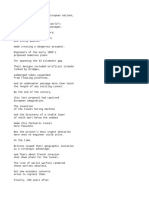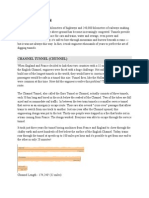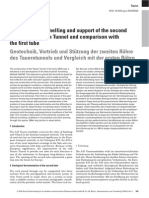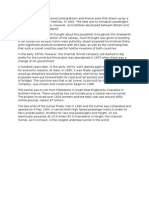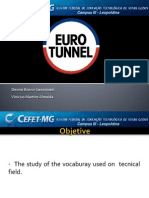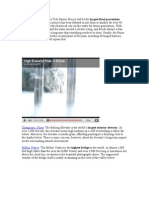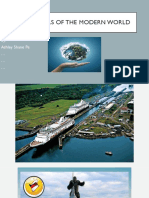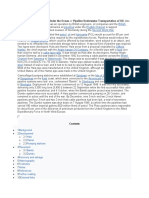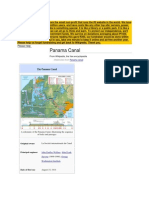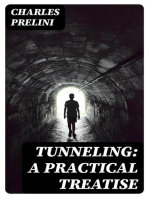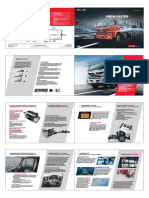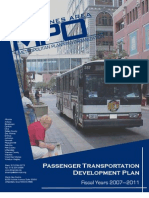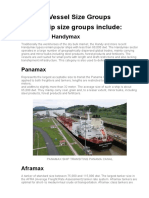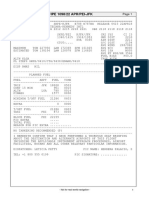Channel
Channel
Uploaded by
Jigar PalCopyright:
Available Formats
Channel
Channel
Uploaded by
Jigar PalCopyright
Available Formats
Share this document
Did you find this document useful?
Is this content inappropriate?
Copyright:
Available Formats
Channel
Channel
Uploaded by
Jigar PalCopyright:
Available Formats
Working from both the English side and the French side of the Channel, eleven tunnel boring
machines cut through chalk marl to construct two rail tunnels and a service tunnel. The vehicle shuttle terminals are at Cheriton (part of Folkestone) and Coquelles, and are connected to the English and French motorways (M20 and A16 respectively). Tunnelling commenced in 1988, and the tunnel began operating in 1994.[26] In 1985 prices, the total construction cost was 4.650 billion (equivalent to 11 billion today), an 80% cost overrun. At the peak of construction 15,000 people were employed with daily expenditure over 3 million.[27] Ten workers, eight of them British, were killed during construction between 1987 and 1993, most in the first few months of boring.[28][29][30]
[edit] Completion
The Channel Tunnel was opened in Calais on 6 May 1994 by British Queen Elizabeth II and French President Franois Mitterrand
Class 319 EMUs ran excursions trips into the Channel Tunnel from Sandling railway station on 7 May 1994, the first passenger trains to do so A small, two-inch (50-mm) diameter pilot hole allowed the service tunnel to break through without ceremony on 30 October 1990.[31] On 1 December 1990, Englishman Graham Fagg and Frenchman Phillippe Cozette broke through the service tunnel with the media watching.[32] Eurotunnel completed the tunnel on time,[24] and the tunnel was officially opened one year later than originally planned by British Queen Elizabeth II and French President Franois Mitterrand in a ceremony held in Calais on 6 May 1994. The Queen travelled through the tunnel to Calais on a Eurostar train, which stopped nose to nose with the train that carried President Mitterrand from Paris.[33] Following the ceremony President Mitterrand and the Queen travelled on Le
Shuttle to a similar ceremony in Folkestone.[33] A full public service did not start for several months. The Channel Tunnel Rail Link (CTRL), now called High Speed 1, runs 69 miles (111 km) from St Pancras railway station in London to the Channel Tunnel portal at Folkestone in Kent. It cost 5.8 billion. On 16 September 2003 UK Prime Minister Tony Blair opened the first section of High Speed 1, from Folkestone to north Kent. On 6 November 2007 the Queen officially opened High Speed 1 and St Pancras International station,[34] replacing the original slower link to Waterloo International railway station. On High Speed 1 trains travelling at speeds up to 300 km/h (186 mph), the journey from London to Paris takes 2 hours 15 minutes and London to Brussels takes 1 hour 51 minutes.[35] In 1996, the American Society of Civil Engineers, with Popular Mechanics, selected the tunnel as one of the Seven Wonders of the Modern World.[8]
[edit] Engineering
The Channel Tunnel exhibit at the National Railway Museum in York, England, showing the circular cross section of the tunnel with the overhead line powering a Eurostar train. Also visible is the segmented tunnel lining Surveying undertaken in the twenty years before tunnel construction confirmed earlier speculations that a tunnel route could be bored through a chalk marl stratum. The chalk marl was conducive to tunnelling, with impermeability, ease of excavation and strength. While on the English side the chalk marl ran along the entire length of the tunnel, on the French side a length of 5 kilometres (3 mi) had variable and difficult geology. The Channel Tunnel consists of three bores: two 7.6-metre (25 ft) diameter rail tunnels, 30 metres (98 ft) apart, 50 kilometres (31 mi) in length with a 4.8-metre (16 ft) diameter service tunnel in between. There are also crosspassages and piston relief ducts. The service tunnel was used as a pilot tunnel, boring ahead of
the main tunnels to determine the conditions. English access was provided at Shakespeare Cliff, while French access came from a shaft at Sangatte. The French side used five tunnel boring machines (TBMs); the English side used six. The service tunnel uses Service Tunnel Transport System (STTS) and Light Service Tunnel Vehicles (LADOGS). Fire safety was a critical design issue. Between the portals at Beussingue and Castle Hill the tunnel is 50.5 kilometres (31 mi) long, with 3.3 kilometres (2 mi) under land on the French side, 9.3 kilometres (6 mi) under land on the UK side and 37.9 kilometres (24 mi) under sea.[5] This makes the Channel Tunnel the second longest rail tunnel in the world, behind the Seikan Tunnel in Japan, but with the longest undersea section.[36] The average depth is 45 metres (148 ft) below the seabed.[37] On the UK side, of the expected 5 million cubic metres (6.5106 cu yd) of spoil approximately 1 million cubic metres (1.3106 cu yd) was used for fill at the terminal site, and the remainder was deposited at Lower Shakespeare Cliff behind a seawall, reclaiming 74 acres (30 ha)[27] of land.[38] This land was then made into the Samphire Hoe Country Park. Environmental impact assessment did not identify any major risks for the project, and further studies into safety, noise, and air pollution were overall positive. However, environmental objections were raised over a high-speed link to London.[39]
[edit] Geology
Geological profile along the tunnel as constructed. For the majority of its length the tunnel bores through a chalk marl stratum (layer) Successful tunnelling under the channel required a sound understanding of the topography and geology and the selection of the best rock strata through which to tunnel. The geology generally consists of northeasterly dipping Cretaceous strata, part of the northern limb of the WealdenBoulonnais dome. Characteristics include:
Continuous chalk on the cliffs on either side of the Channel containing no major faulting, as observed by Verstegan in 1698 Four geological strata, marine sediments laid down 90100 million years ago; pervious upper and middle chalk above slightly pervious lower chalk and finally impermeable Gault Clay. A sandy stratum, glauconitic marl (tortia), is in between the chalk marl and gault clay A 2530-metre (8298 ft) layer of chalk marl (French: craie bleue) in the lower third of the lower chalk appeared to present the best tunnelling medium. The chalk has a clay content of 3040% providing impermeability to groundwater yet relatively easy excavation with strength allowing minimal support. Ideally the tunnel would be bored in the bottom 15 metres (49 ft) of the chalk marl, allowing water inflow from fractures and
joints to be minimised, but above the gault clay that would increase stress on the tunnel lining and swell and soften when wet.[40] On the English side of the channel, the strata dip less than 5, however, on the French side, this increases to 20. Jointing and faulting is present on both the English and French sides. On the English side, only minor faults of displacement less than 2 metres (7 ft) exist. On the French side, displacements of up to 15 metres (49 ft) are present owing to the Quenocs anticlinal fold. The faults are of limited width, filled with calcite, pyrite and remoulded clay. The increased dip and faulting restricted the selection of route on the French side. To avoid confusion, microfossil assemblages were used to classify the chalk marl. On the French side, particularly near the coast, the chalk was harder, and more brittle, and more fractured than on the English side. This led to the adoption of different tunnelling techniques on the French and English sides.[41] The Quaternary undersea valley Fosse Dangaered, and Castle Hill landslip, located at the English portal, caused concerns. Identified by the 196465 geophysical survey, the Fosse Dangaered is an infilled valley system extending 80 metres (262 ft) below the seabed, 500 metres (1,640 ft) south of the tunnel route, located mid-channel. A 1986 survey showed that a tributary crossed the path of the tunnel, and so the tunnel route was made as far north and deep as possible. The English terminal had to be located in the Castle Hill landslip, which consists of displaced and tipping blocks of lower chalk, glauconitic marl and gault debris. Thus the area was stabilised by buttressing and inserting drainage adits.[41] The service tunnels were pilot tunnels preceding the main tunnels, so that the geology, areas of crushed rock, and zones of high water inflow could be predicted. Exploratory probing took place in the service tunnels, in the form of extensive forward probing, vertical downward probes and sideways probing.[41]
[edit] Surveying
Marine soundings and samplings by Thom de Gamond were carried out during 18331867, establishing the seabed depth at a maximum of 55 metres (180 ft) and the continuity of geological strata (layers). Surveying continued over many years, with 166 marine and 70 landdeep boreholes being drilled and over 4,000-line-kilometres of marine geophysical survey completed.[42] Surveys were undertaken in 19581959, 19641965, 19721974 and 19861988. The surveying in 19581959 catered for immersed tube and bridge designs as well as a bored tunnel, and thus a wide area was investigated. At this time marine geophysics surveying for engineering projects was in its infancy, with poor positioning and resolution from seismic profiling. The 19641965 surveys concentrated on a northerly route that left the English coast at Dover harbour; using 70 boreholes, an area of deeply weathered rock with high permeability was located just south of Dover harbour.[42] Given the previous survey results and access constraints, a more southerly route was investigated in the 19721973 survey and the route was confirmed to be feasible. Information for the tunnelling project also came from work before the 1975 cancellation. On the French side at Sangatte a deep shaft with adits was made. On the English side at Shakespeare Cliff, the government allowed 250 metres (820 ft) of 4.5-metre (15 ft) diameter tunnel to be driven. The actual tunnel alignment, method of excavation and support were essentially the same as the 1975
attempt. In the 19861997 survey, previous findings were reinforced and the nature of the gault clay and the tunnelling medium (chalk marl that made up 85% of the route) were investigated. Geophysical techniques from the oil industry were employed.[42]
[edit] Tunnelling
Typical tunnel cross section, with a service tunnel between twin rail tunnels. Shown linking the rail tunnels is a piston relief duct, necessary to manage pressure changes due to the movement of trains Tunnelling between England and France was a major engineering challenge, with the only precedent being the undersea Seikan Tunnel in Japan. A serious risk with underwater tunnels is major water inflow due to the water pressure from the sea above under weak ground conditions. The Channel Tunnel also had the challenge of timebeing privately funded, early financial return was paramount. The objective was to construct: two 7.6-metre (25 ft) diameter rail tunnels, 30 metres (98 ft) apart, 50 kilometres (31 mi) in length; a 4.8-metre (16 ft) diameter service tunnel between the two main tunnels; pairs of 3.3-metre (11 ft) diameter cross-passages linking the rail tunnels to the service tunnel at 375-metre (1,230 ft) spacing; piston relief ducts 2-metre (7 ft) diameter connecting the rail tunnels at 250-metre (820 ft) spacing; two undersea crossover caverns to connect the rail tunnels.[43] The service tunnel always preceded the main tunnels by at least 1 kilometre (0.6 mi) to ascertain the ground conditions. There was plenty of experience with tunnelling through chalk in the mining industry. The undersea crossover caverns were a complex engineering problem. The French cavern was based on the Mount Baker Ridge freeway tunnel in the US. The UK cavern was dug from the service tunnel ahead of the main tunnels to avoid delay. Precast segmental linings in the main TBM drives were used, but different solutions were used on the English and French sides. On the French side, neoprene and grout sealed bolted linings made of cast iron or high-strength reinforced concrete were used. On the English side, the main requirement was for speed and bolting of cast-iron lining segments was only carried out in areas of poor geology. In the UK rail tunnels, eight lining segments plus a key segment were used; on the French side, five segments plus a key segment.[44] On the French side, a 55-metre (180 ft) diameter 75-metre (246 ft) deep grout-curtained shaft at Sangatte was used for access. On the English side, a marshalling area was 140 metres (459 ft) below the top of Shakespeare Cliff, and the New Austrian Tunnelling method (NATM) was first applied in the chalk marl here. On the English side, the land tunnels were driven from Shakespeare Cliff, the same place as the marine tunnels, not from Folkestone. The platform at the base of the cliff was not large enough for all of the drives and, despite environmental objections, tunnel spoil was placed behind a reinforced
concrete seawall, on condition of placing the chalk in an enclosed lagoon to avoid wide dispersal of chalk fines. Owing to limited space, the precast lining factory was on the Isle of Grain in the Thames estuary.[43] On the French side, owing to the greater permeability to water, earth pressure balance TBMs with open and closed modes were used. The TBMs were of a closed nature during the initial 5 kilometres (3 mi), but then operated as open, boring through the chalk marl stratum.[43] This minimised the impact to the ground and allowed high water pressures to be withstood, and it also alleviated the need to grout ahead of the tunnel. The French effort required five TBMs: two main marine machines, one main land machine (the short land drives of 3 km allowed one TBM to complete the first drive then reverse direction and complete the other), and two service tunnel machines. On the English side, the simpler geology allowed faster open-faced TBMs.[45] Six machines were used, all commenced digging from Shakespeare Cliff, three marine-bound and three for the land tunnels.[43] Towards the completion of the undersea drives, the UK TBMs were driven steeply downwards and buried clear of the tunnel. These buried TBMs were then used to provide an electrical earth. The French TBMs then completed the tunnel and were dismantled.[46] A 900 mm gauge railway was used on the English side during construction.[47]
You might also like
- Oresund BridgeDocument46 pagesOresund BridgeHamza Qureshi67% (3)
- Executive SummaryDocument65 pagesExecutive Summaryakshay_kotkar_1No ratings yet
- Imperial Sugar FactoryDocument16 pagesImperial Sugar FactoryNataraj Naik Banavath ch20m025No ratings yet
- Channel Tunnel. Advantages N SafetyDocument9 pagesChannel Tunnel. Advantages N SafetyAkhilesh GojeNo ratings yet
- The Channel Tunel Questions and DiscussionsDocument3 pagesThe Channel Tunel Questions and DiscussionsPelagie DucatNo ratings yet
- (English) How The World's Longest Underwater Tunnel Was Built - Alex Gendler (DownSub - Com)Document4 pages(English) How The World's Longest Underwater Tunnel Was Built - Alex Gendler (DownSub - Com)gfffNo ratings yet
- Channel Tunnel AnswersDocument4 pagesChannel Tunnel AnswersPelagie DucatNo ratings yet
- The Channel Tunnel-CASE STUDYDocument9 pagesThe Channel Tunnel-CASE STUDYUmang sharmaNo ratings yet
- Underwater RailwaysDocument34 pagesUnderwater RailwaysMukul RaisinghaniNo ratings yet
- Excavation Methods in TunnelingDocument17 pagesExcavation Methods in Tunnelingcbelhann1No ratings yet
- The Channel Tunnel .Document10 pagesThe Channel Tunnel .Полина РемизоваNo ratings yet
- Fig 1.1 Proposals Presented in 1985. Left: Eurobridge, Middle: Euroroute, Right: Channel TunnelDocument17 pagesFig 1.1 Proposals Presented in 1985. Left: Eurobridge, Middle: Euroroute, Right: Channel TunnelAnithaNo ratings yet
- Milau ViaductDocument15 pagesMilau ViaductVenkatesh KammineniNo ratings yet
- Tunnel Boring MachinesDocument2 pagesTunnel Boring MachinesNdanu MercyNo ratings yet
- TunnelsDocument4 pagesTunnelsPaul ButucNo ratings yet
- CDocument2 pagesCidonotspammeNo ratings yet
- Introduction To Tunnel Construction: Chapter-1Document10 pagesIntroduction To Tunnel Construction: Chapter-1Saurabh YeleNo ratings yet
- EnglezaDocument8 pagesEnglezaDanu GolbanNo ratings yet
- Tunnel - WikipediaDocument2 pagesTunnel - WikipediaidonotspammeNo ratings yet
- Geotechnics, TunnellingDocument12 pagesGeotechnics, TunnellingMohamed MekkawyNo ratings yet
- The Channel TunnelDocument1 pageThe Channel TunnelIva SivarajaNo ratings yet
- Submerged Floating TunnelDocument9 pagesSubmerged Floating TunnelSrinith Kumar100% (1)
- Warren Thames XP2003Document14 pagesWarren Thames XP2003Sajjad AnwarNo ratings yet
- Trabalho de InglêsDocument14 pagesTrabalho de InglêsVinicius MartinsNo ratings yet
- Repair & Modification of NZ Railway TunnelDocument12 pagesRepair & Modification of NZ Railway TunnelAndy AcousticNo ratings yet
- TunnelDocument30 pagesTunnelSubbaReddyNo ratings yet
- Study of Tunnels: Shaikh AdilDocument30 pagesStudy of Tunnels: Shaikh AdilTEJASH INGALENo ratings yet
- Panama Canal - FinalDocument25 pagesPanama Canal - FinalTeeksh Nagwanshi50% (2)
- MiningDocument2 pagesMiningidonotspammeNo ratings yet
- Ce541 Rohit Mtech Civil 3rd Sem H13940Document27 pagesCe541 Rohit Mtech Civil 3rd Sem H13940mohit sharmaNo ratings yet
- Thomas Telford 250 YearsDocument4 pagesThomas Telford 250 Yearscv21joNo ratings yet
- Mna-034 CT 07 ADocument19 pagesMna-034 CT 07 ASenthil NathNo ratings yet
- Architecture!Document3 pagesArchitecture!Matt SwedlowNo ratings yet
- 7 Wonders of The Modern WorldDocument9 pages7 Wonders of The Modern WorldOliver tomasNo ratings yet
- Tunnels ScriptDocument1 pageTunnels ScriptIvanStanicNo ratings yet
- Evolution of Transport SystemsDocument11 pagesEvolution of Transport SystemsPaulpablo ZaireNo ratings yet
- Tresaguet and ThomasDocument3 pagesTresaguet and ThomascherrielNo ratings yet
- How The Chunnel Changed Europe ForeverDocument3 pagesHow The Chunnel Changed Europe ForevermxxclsNo ratings yet
- AnglaisDocument5 pagesAnglaisHabibboullah Cheikh sidiyaNo ratings yet
- Old TransportationDocument17 pagesOld Transportationanon_370263793No ratings yet
- Tunnel Engineering 2Document34 pagesTunnel Engineering 2Ankit PatelNo ratings yet
- Operation PlutoDocument6 pagesOperation PlutoSon Chaeyoung MinariNo ratings yet
- Tunneling Methods 5Document32 pagesTunneling Methods 5VivekNo ratings yet
- Tunnels and Underground Excavations History, Methods, Uses, Facts BritannicaDocument29 pagesTunnels and Underground Excavations History, Methods, Uses, Facts BritannicaharoonkhanNo ratings yet
- LEngineering Geology of Alpine Tunnels: Past, Present and Futureoew - Et - Al - 2010Document53 pagesLEngineering Geology of Alpine Tunnels: Past, Present and Futureoew - Et - Al - 2010MAPV1945No ratings yet
- Panama CanalDocument53 pagesPanama Canalcjcute91No ratings yet
- Civilnews 10Document8 pagesCivilnews 10adip1971890No ratings yet
- Interim Report 2007 - Mellor ExcavationsDocument78 pagesInterim Report 2007 - Mellor ExcavationsdigitalpastNo ratings yet
- Highway HistoryDocument4 pagesHighway HistoryJoyce EspirituNo ratings yet
- Transportation Engineering - Ce111 - Bsce1a - G1Document34 pagesTransportation Engineering - Ce111 - Bsce1a - G1Jasmine-Nezzar ImbigNo ratings yet
- Wikipedia TunnelDocument16 pagesWikipedia TunnelPrince Of'boyNo ratings yet
- Historical Development of Transportation Mobility and Social, Technological, and Environmental ChangesDocument12 pagesHistorical Development of Transportation Mobility and Social, Technological, and Environmental Changesliezyl MantaringNo ratings yet
- Galton BridgeDocument2 pagesGalton BridgeTashi SultanNo ratings yet
- Tunnels: Ancient Roman AqueductDocument4 pagesTunnels: Ancient Roman AqueductRotar MihaiNo ratings yet
- AtlasCopco Underground ConstructionDocument284 pagesAtlasCopco Underground ConstructionJack100% (3)
- CANAL (G) The Suez and Panama Canals PDFDocument7 pagesCANAL (G) The Suez and Panama Canals PDFMIKHA2014No ratings yet
- Construction - Princes Highway Ramp Soft Ground Tunnel: A. Nancarrow M. LechnerDocument13 pagesConstruction - Princes Highway Ramp Soft Ground Tunnel: A. Nancarrow M. LechnerHarold TaylorNo ratings yet
- I-4.1 History of Civil Engineering and Infrastructure 2022FDocument62 pagesI-4.1 History of Civil Engineering and Infrastructure 2022F鄧和傑No ratings yet
- Transactions of the American Society of Civil Engineers, vol. LXVIII, Sept. 1910 The New York Tunnel Extension of the Pennsylvania Railroad. The East River Tunnels. Paper No. 1159From EverandTransactions of the American Society of Civil Engineers, vol. LXVIII, Sept. 1910 The New York Tunnel Extension of the Pennsylvania Railroad. The East River Tunnels. Paper No. 1159No ratings yet
- Wartezeiten Mietpreisliste EnglischDocument3 pagesWartezeiten Mietpreisliste EnglischMelissa penayeNo ratings yet
- Profiles 737Document13 pagesProfiles 737aske7sp8055100% (1)
- Flyer-U2000-400 2018 en RGBDocument2 pagesFlyer-U2000-400 2018 en RGBLukáš ČochnerNo ratings yet
- M.B.A (CBCS Pattern) (For The Affiliated College Students Admitted During The Academic Year 20012-13&onwards) ExaminationsDocument11 pagesM.B.A (CBCS Pattern) (For The Affiliated College Students Admitted During The Academic Year 20012-13&onwards) ExaminationsRamkumarNo ratings yet
- Reference For TdanoDocument11 pagesReference For TdanoPrinces Ann MarcosNo ratings yet
- Farrier 2012 Sailing ManualDocument52 pagesFarrier 2012 Sailing ManualJoao CalinhoNo ratings yet
- Eicher Pro 6041Document1 pageEicher Pro 6041Rohit ChatterjeeNo ratings yet
- Egp 04 01Document11 pagesEgp 04 01jkhgvdj mnhsnjkhgNo ratings yet
- Passenger Transportation Plan 2007Document58 pagesPassenger Transportation Plan 2007bethanywilcoxonNo ratings yet
- Vin ReportDocument8 pagesVin ReportrezziNo ratings yet
- Bridges & Structures PDFDocument6 pagesBridges & Structures PDFDeeptiranjan NagNo ratings yet
- Printticket JSF PDFDocument2 pagesPrintticket JSF PDFAnonymous c6dXJX933No ratings yet
- District Quality Assurance Unit: Republic of The Philippines Department of Public Works and HighwaysDocument21 pagesDistrict Quality Assurance Unit: Republic of The Philippines Department of Public Works and HighwaysNovelyn AlmojuelaNo ratings yet
- Vessel Size Groups Major Ship Size Groups Include:: Handy and HandymaxDocument3 pagesVessel Size Groups Major Ship Size Groups Include:: Handy and HandymaxGiorgi KandelakiNo ratings yet
- Pirpanjal Railway TunnelDocument84 pagesPirpanjal Railway TunnelSaurabh Singh Rajput100% (3)
- Skpekjfk PDF 1524370503Document63 pagesSkpekjfk PDF 1524370503Santiago Herrera PalacioNo ratings yet
- Analysis and Predict The Nature of Road Traffic Accident Using Data Mining Techniques in Maharashtra, IndiaDocument11 pagesAnalysis and Predict The Nature of Road Traffic Accident Using Data Mining Techniques in Maharashtra, IndiaBayeNo ratings yet
- 1604-Tororo-Pakwach - Consultancy - of - Feasibility - Final Report - 2016-10-18 PDFDocument183 pages1604-Tororo-Pakwach - Consultancy - of - Feasibility - Final Report - 2016-10-18 PDFpepegrillo891No ratings yet
- Passenger Locator Form: STATUS: Airside TransitDocument3 pagesPassenger Locator Form: STATUS: Airside TransitMERLITO HERRERANo ratings yet
- Unit 4: Sitcom: What Happened To You?! Scene 1Document1 pageUnit 4: Sitcom: What Happened To You?! Scene 1Jesús UribeNo ratings yet
- Om. Husqvarna. R 316t, R 316t Awd, R 316ts Awd, R 316txs Awd. 2016-01Document36 pagesOm. Husqvarna. R 316t, R 316t Awd, R 316ts Awd, R 316txs Awd. 2016-01Jukka PeltonenNo ratings yet
- Passenger Rail & Transit Rail Manufacturing in The U.SDocument44 pagesPassenger Rail & Transit Rail Manufacturing in The U.SCDI Global India100% (1)
- Industry 4.0 Warehouse Automation Whitepaper AddverbDocument20 pagesIndustry 4.0 Warehouse Automation Whitepaper AddverbRAMESH100% (1)
- Downstream Oil TheftDocument116 pagesDownstream Oil TheftThe Atlantic CouncilNo ratings yet
- Chap 015Document32 pagesChap 015fadzliza_83No ratings yet
- 94 Supra Wiring DiagramsDocument59 pages94 Supra Wiring DiagramsGaston MerinoNo ratings yet
- Course Outline: Reference: CHED Memorandum Order No. 92 Series 2017Document17 pagesCourse Outline: Reference: CHED Memorandum Order No. 92 Series 2017John David RomasantaNo ratings yet
- Question Paper Project Management - II (242) : October 2004: Section D: Case Study (50 Marks)Document19 pagesQuestion Paper Project Management - II (242) : October 2004: Section D: Case Study (50 Marks)api-27548664No ratings yet





